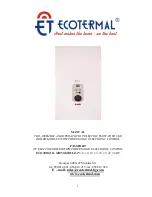
First commissioning
56
CHECKS AFTER COMMISSIONING
With cold start, check that:
–
the water level is 60 mm above the minimum level (LWL) indicated on the level indicator; the water volume increase due to
heating (water thermal expansion) should not be excessive in order to avoid having to drain water at regular intervals to bring
the level back to half scale on the glass indicator
–
once the set pressure has been reached, the steam outlet valve must be opened gradually in order to heat the delivery pipe
by eliminating any condensate present inside ducts
–
the manhole gasket seals.
STOP PERIODS
The most serious corrosions for the generator often occur during the stop periods.
The operations to be carried out to ensure a correct storage of the generator mainly depend on the duration of the stop time.
When the generator has to remain unused
for long periods
a
dry storage
is recommended. When the stop times are
for short
periods
or when the generator has a backup function and must be able to become operational in a short time, a
wet storage
is
recommended.
In both cases, the operations described below tend to eliminate any possible cause of corrosion.
The wet storage, whenever possible, reduces the interval necessary to reach the operating conditions.
Dry storage
Empty and thoroughly dry the generator, then inject a dessicant (such as quicklime, silica gel, etc.) inside the cylindrical body.
Wet storage
Drain water and perform a complete cleaning of the generator. Fill the body up to the normal operating level and, after a short
evaporation time, blowdown to the atmosphere to eliminate all dissolved gases. Then completely fill the generator, with a correct
metering of DEHA (diethyl hydroxyl amine) to develop a residual concentration of more than 100 ppm preventing the attacks of
the oxygen dissolved in water. Add also trisodium phosphate to ensure a total alkalinity above 400 ppm.
Then close all connections.
Make sure that there are no leaks from connections or junctions and take some water samples at regular intervals in order to check
that the alkalinity value has not been altered.
















































